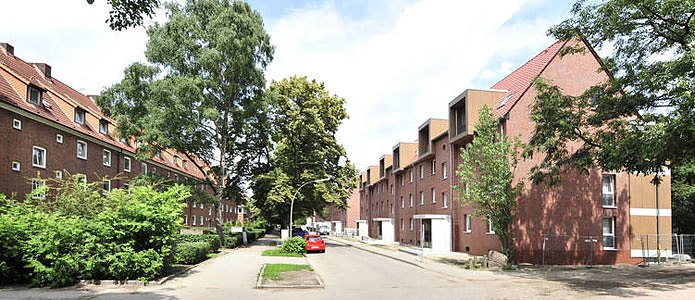Urban Development
Strengthening Social Cohesion

Urban developers have long since realised that residential areas with large numbers of disadvantaged families need special attention. This can lead to the atmosphere significantly improving for the residents.
When it comes to many different nationalities getting along together, different standards seem to prevail in the big football stadiums, compared to the local amateur playing fields of Germany. Professional teams, in which players have different nationalities, are expected to produce great sporting achievements. The same situation, when kids from different backgrounds have a kick-about in front of a high-rise building on a housing estate, on the other hand, is often interpreted as a social alarm signal. The reason being that for an area to be considered a “problem district”, it is commonly accepted that it has to have a certain number of people living there from an immigrant background.
On the sports fields of Billstedt and Wilhelmsburg – two Hamburg neighbourhoods that consistently earn the “very low” status in the city's annual social monitoring survey – there are indeed children of different origins and skin colour romping about with a ball. Where some people, however, might see an alarm signal, the reality is actually a group of markedly cheerful, sporty and stylishly dressed amateur players, ranting and raving in German without a trace of an accent.
Ghetto fantasy or suburban idyll
Nevertheless, according to recurring media reports Billstedt has earned a name for itself as the “ghetto of dealers and knife wielders”. And this image has not only been spread by the tabloid media. Statistical material about the area brings worry lines to the brows of politicians when they speak about the districts of Hamburg East: 22 per cent on welfare, about ten per cent unemployed, 72 per cent of under 18 year olds come from an immigrant background. Indicators like these spawn ghetto fantasies.In reality, this large district on the border to the state of Schleswig-Holstein provides a surprisingly contrasting picture. Old and new detached houses with rose bushes in the front garden dominate the area around the underground station, not to mention a few apartment buildings with no more than three storeys, some from the Gründerzeit – the period of rapid industrial expansion in Germany. Satellite dishes on balconies as a sign of homesickness are rare, German national flags, on the other hand, not only decorate the houses during international sports tournaments.
Not until Mümmelmannsberg, an estate on the outskirts of the district, does this petty-bourgeois idyll come to an end. Surrounded by a nature reserve, it is a typical commuter town, built in the 1970s, with terraced houses and high-rise buildings that has managed to accrue a large proportion of social housing within a small space.
The playgrounds and brightly coloured balconies of “Killstedt”
But this estate, too, does not quite look like a “no-go area”. There are many playgrounds and lots of different kinds of trees accentuating the clearings between the simple and cheap, but decent architecture, which in many places has recently been renovated and provided with new balconies. Almost every balcony is full of colourful plants. There is definitely no sign of the gangs of “Killstedt”, as Hamburg's largest local newspaper once called the area.There are without a doubt still problems with young people, with ghetto posturing and aggressive crimes in this purely residential estate that has been left behind economically. However, when it comes to crime statistics, Billstedt is under the average for Hamburg. And the trend is clearly positive – the same goes for Wilhelmsburg, the district, on an island in the river Elbe, with the highest proportion of foreigners and an ugly image. According to this image, the Hanseatic citizens of Hamburg allegedly dump everything they do not want on their own doorstep on Wilhelmsburg: industry, toxic waste and poor people.
New schools, a swimming pool and an indoor climbing wall
To trigger a turnaround, from 2007 to 2013 an international building exhibition was held in Wilhelmsburg, followed by the German Federal Garden Show, with the aim of improving the quality of housing and infrastructure. Schools were built, residential quarters modernised, compacted and rebuilt and a large central park was created. In addition, a swimming pool, a climbing centre and several other facilities for leisure and further training were built in the “Cosmopolis” of Wilhelmsburg with its 80 different nations.The fact that one billion euros was invested in this, a third of it from public funds, can certainly count as a special case. The realisation, however, that residential areas with a high poverty rate require special attention has long since been widely accepted as a principle of urban development. However, it is still a lack of resources that prevents projects from getting off the ground.